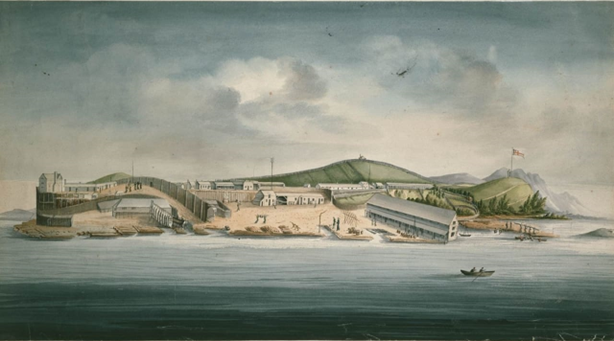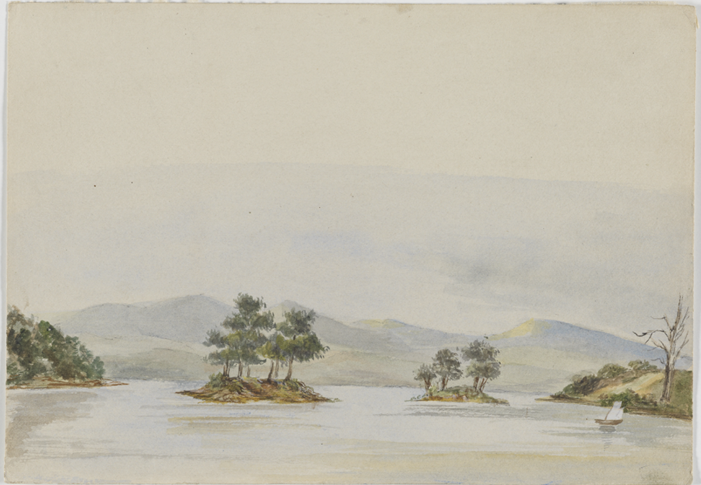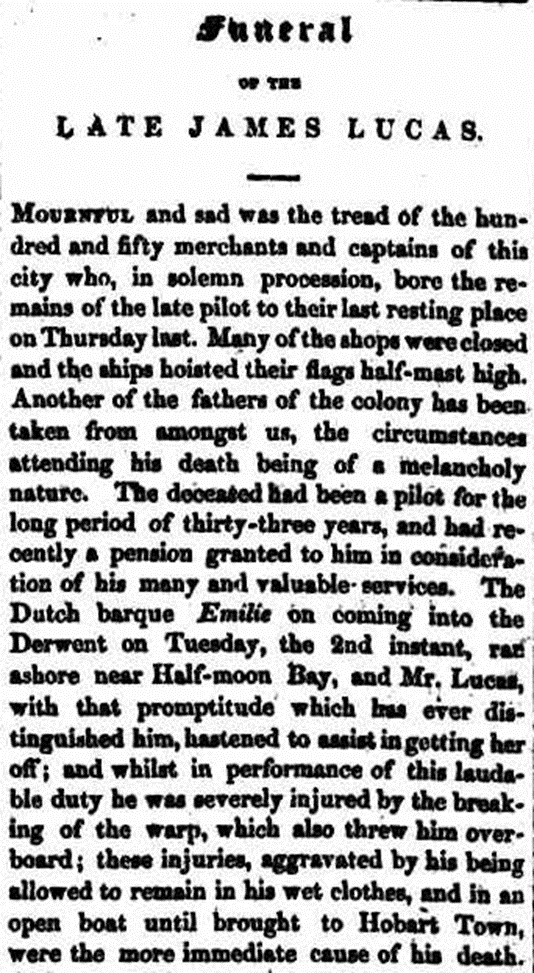Stories from the Royal Society of Tasmania Art Collection
8. Captain James Lucas (1792?-1853)
Article prepared by the RST Honorary Curator, Dr Anita Hansen, for the September 2022 RST Newsletter
This month I will look at the work of another naval officer, Captain James Lucas. There is no record of how the eight watercolours by James Lucas came to be in the Royal Society of Tasmania Art Collection. It may have been part of the push by the Royal Society to collect items relating to Tasmanian history in around 1900 (see previous Newsletter articles about this).
There seems to be some question about when and where James Lucas was born. According the Australian Dictionary of Biography (ADB), he was born either at Norfolk Island – where his father Lieutenant James Hunt Lucas was stationed – in 1792, or in Sydney in 1791.
His early career was as a naval officer, although I have found no record of where he trained. It may be that he received his training through working his way up through the ranks onboard ships, rather than attending a naval college. It has been written that at an early age he was enlisted as midshipman in the Porpoise under Matthew Flinders and was in that ship when it was wrecked on the east coast of Australia in August 1803 (ADB). Such a young age – he would have been only ten or eleven! He served for three years in the Buffalo, two years as second officer and chief officer in the Kangaroo and then four years as chief officer in the Elk.
At the age of about thirty in 1821, he was appointed as the harbourmaster and pilot of the newly formed penal settlement of Macquarie Harbour. He was stationed at Cape Sorell and for eight years piloted across the shallow and treacherous entrance most vessels making for Macquarie Harbour. (ADB).

William Buelow Gould c.1832.
Courtesy of the Allport Library and Museum of Fine Arts.
Escaping Convicts
In this job Lucas was occasionally sent along the coast to search for escaping convicts and recaptured a number of them. It was noted in his Obituary in the Colonial Times that, ‘He captured [Alexander] Pierce, the bush ranger, who with seven others absconded from that place, and were so reduced by hunger that they drew lots to decide who should die to provide for the others. This horrid cannibalism continued until none survived except Pierce, in whose possession were found portions of a human body.’
Leaving Macquarie Harbour
During his time at Macquarie Harbour, Lucas met a female convict named Margaret Keefe and they had three or four children [accounts vary]. Initially the couple lived together unmarried and were consequently shunned by the Commandant. When they did marry, the Commandant did not attend the wedding.
This, and the dangers of the job when encountering escaping convicts there, led Lucas to apply for less perilous appointment. In November 1829 he was stationed at Point Louis in d’Entrecasteaux Channel as a pilot.
The two paintings I have included in this article were painted at this time.
In all the material I have been able to find about James Lucas, there is no record of where or when he learned to paint. It seems likely that he may have observed the English-trained naval officers he served with painting coastal panoramas and learned from them. While his works may not be as skilful as some in the Royal Society’s collection, they are quite well observed and are valuable images of nineteenth century Tasmania.

Royal Society of Tasmania Art Collection.
While stationed at Point Luis he applied for land on Slopen Island. However, he was refused this by the Land Board on the ground that farming pursuits would be liable to divert a pilot’s attention from his important public duties; later, however, he received 100 acres (40 ha) at Point Louis.
In June 1853, after thirty-five years in government service, he applied for a pension. Some weeks later – always ready to help those in distress – he went to the assistance of the Dutch barque Emilie, aground at Halfmoon Bay. During this mission Lucas was severely injured when the warp line broke. He was taken to St Mary’s hospital, where he died on 5 August 1853.
He must have been a popular member of the community, for a moving obituary was placed in the Colonial Times Hobart on Saturday 13 August 1853 (p3).
Obituary in full
FUNERAL of the LATE JAMES LUCAS.
MOURNFUL and sad was the tread of the hundred and fifty merchants and captains of this city who, in solemn procession, bore the remains of the late pilot to their last resting place on Thursday last. Many of the shops were closed and the ships hoisted their flags half-mast high. Another of the fathers of the colony has been taken from amongst us, the circumstances attending his death being of a melancholy nature.
The deceased had been a pilot for the long period of thirty-three years, and had recently a pension granted to him in consideration of his many and valuable services. The Dutch barque Emilie on coming into the Derwent on Tuesday, the 2nd instant, ran ashore near Half-moon Bay, and Mr. Lucas, with that promptitude which has ever distinguished him, hastened to assist in getting her off; and whilst in performance of this laudable duty he was severely injured by the breaking of the Warp, which also threw him over board; these injuries, aggravated by his being allowed to remain in his wet clothes, and in an open boat until brought to Hobart Town, were the more immediate cause of his death.
A sketch of Mr. Lucas’ career may not be unacceptable to our readers, amongst whom we believe, he numbered a great many personal friends. He was born at Norfolk Island, and had been in the service of the crown in various capacities upwards of 40 years. As master at Macquarie Harbour for upwards of nine years, he encountered many dangers whilst in pursuit of bush rangers and absconders from that settlement ; the government frequently expressing their sense of his services.
He captured Pierce, the bush ranger, who with seven others absconded from that place, and were so reduced by hunger that they drew lots to decide who should die to provide for the others. This horrid cannibalism continued until none survived except Pierce, in whose possession were found portions of a human body.
On one occasion his boat was upset whilst in pursuit of bush rangers, and five of the crew were drowned ; but Mr. Lucas swam a distance of three miles, and even succeeded in saving one of the men. Whilst in pursuit of Brady, who kept the colony in terror for some time; he was very severely stabbed by one of his own crew to prevent his success, but notwithstanding the delay caused by such a foul deed, although Brady had nine days start, he only reached Hobart Town, a few hours before Mr. Lucas.
When Lieutenant Wright was in charge at Macquarie Harbour, on one occasion provisions were so scarce that starvation seemed to be inevitable ; but Mr. Lucas being sent to Hobart Town in a whale-boat for supplies, made such strenuous exertions as caused it to be acknowledged that he was mainly instrumental in saving the lives of all the settlement. At one time the bushrangers succeeded in disarming four soldiers who were in pursuit of them, when Mr. Lucas came upon and captured them ; recovering the fire-arms for the rightful owners.
He was once fastened below in a small schooner by the convicts who held an axe over his head threatening to take his life ; after which, six of them took his boat and made off, but not deterred by their violence or threats he went in pursuit next day and captured two of them at Circular Head. Other equally daring and remarkable events signified his life, but we have related sufficient to prove his worth. Under a tough exterior Mr. Lucas concealed a generous and humane disposition. His death will be felt as a loss by many of the poor who were the objects of his bounty; he was also a liberal subscriber to public and private charities. Although a member of the Order of Freemasons, his sympathies were not confined to them. The large attendance at his funeral proved how much he was esteemed and regretted by all classes of the community, and we believe this feeling will be more forcibly expressed by a monument to be erected to his memory by the mercantile
Last Word
If anyone has any more information about James Lucas’s art – training or other artworks – I would be interested in learning more about this interesting man. It is important that we know about and recognise the early artists of Tasmania.
Anita Hansen


